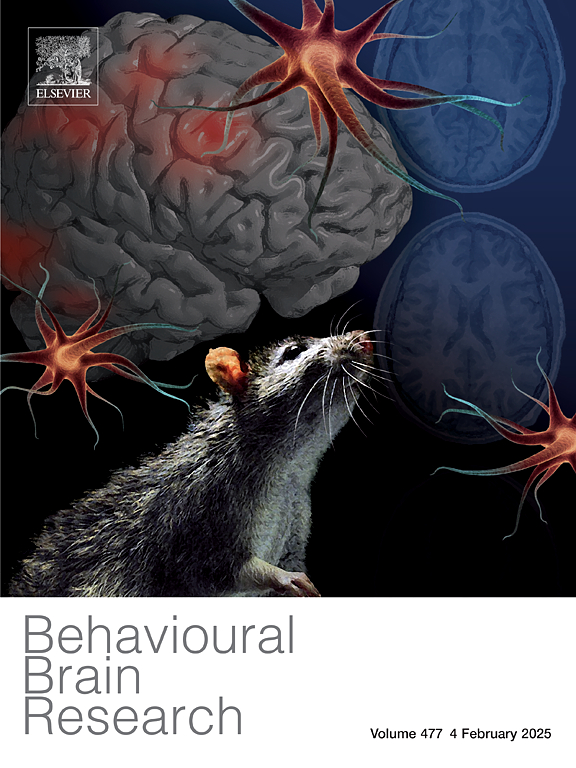L-type calcium channel blockade attenuates cue-induced cocaine-seeking in female rats
IF 2.3
3区 心理学
Q2 BEHAVIORAL SCIENCES
引用次数: 0
Abstract
Periods of cocaine abstinence are associated with a high risk of relapse, often triggered by exposure to drug-associated cues. Previous research has implicated L-type calcium channels (LTCCs) in drug-seeking behaviors, yet their role in cue-induced relapse, particularly in females, remains underexplored. This study investigated the effects of LTCC inhibition on cue-induced cocaine-seeking behavior during abstinence in female Sprague-Dawley rats. Following a 10-day cocaine self-administration and a 14-day forced abstinence period, the rats were tested for cue-induced cocaine-seeking after receiving systemic administration of isradipine, a non-selective LTCC inhibitor (0.0 mg/kg, 0.1 mg/kg, 0.4 mg/kg, or 1.2 mg/kg, i.p.). Isradipine significantly reduced cue-induced cocaine-seeking in a dose-dependent manner without affecting cocaine-taking or natural reward-taking or seeking behaviors. Notably, these findings in females were comparable to our prior results observed in males, demonstrating that LTCC inhibition selectively attenuates the impact of cocaine-associated cues across sexes. These results highlight the translational potential of LTCCs as a therapeutic agent to reduce relapse risk in cocaine-dependent individuals. This study underscores the importance of considering sex-specific mechanisms in addiction treatment and calls for further research into LTCCs as a target for relapse prevention.
l型钙通道阻断可减弱雌性大鼠线索诱导的可卡因寻求
可卡因戒断期与复发的高风险相关,通常是由暴露于与毒品有关的线索引发的。先前的研究表明l型钙通道(ltcc)与药物寻求行为有关,但它们在线索诱导的复发中的作用,特别是在女性中,仍未得到充分研究。本研究探讨了LTCC抑制对雌性Sprague-Dawley大鼠戒断期间线索诱导的可卡因寻求行为的影响。在10天的可卡因自我给药和14天的强制戒断期后,大鼠在全身给予非选择性LTCC抑制剂isradipine(0.0 mg/kg, 0.1 mg/kg, 0.4 mg/kg或1.2 mg/kg, i.p)后,进行线索诱导的可卡因寻找测试。以剂量依赖的方式显著减少线索诱导的可卡因寻求,而不影响可卡因服用或自然的奖励或寻求行为。值得注意的是,这些在女性身上的发现与我们之前在男性身上观察到的结果相当,表明LTCC抑制选择性地减弱了性别间可卡因相关线索的影响。这些结果突出了ltcc作为降低可卡因依赖个体复发风险的治疗药物的转化潜力。这项研究强调了在成瘾治疗中考虑性别特异性机制的重要性,并呼吁进一步研究ltcc作为预防复发的目标。
本文章由计算机程序翻译,如有差异,请以英文原文为准。
求助全文
约1分钟内获得全文
求助全文
来源期刊

Behavioural Brain Research
医学-行为科学
CiteScore
5.60
自引率
0.00%
发文量
383
审稿时长
61 days
期刊介绍:
Behavioural Brain Research is an international, interdisciplinary journal dedicated to the publication of articles in the field of behavioural neuroscience, broadly defined. Contributions from the entire range of disciplines that comprise the neurosciences, behavioural sciences or cognitive sciences are appropriate, as long as the goal is to delineate the neural mechanisms underlying behaviour. Thus, studies may range from neurophysiological, neuroanatomical, neurochemical or neuropharmacological analysis of brain-behaviour relations, including the use of molecular genetic or behavioural genetic approaches, to studies that involve the use of brain imaging techniques, to neuroethological studies. Reports of original research, of major methodological advances, or of novel conceptual approaches are all encouraged. The journal will also consider critical reviews on selected topics.
 求助内容:
求助内容: 应助结果提醒方式:
应助结果提醒方式:


